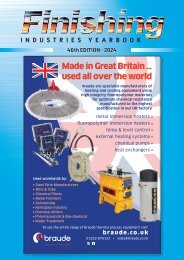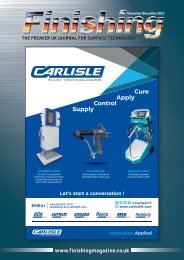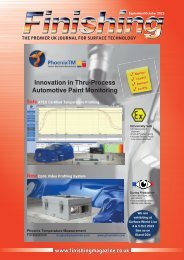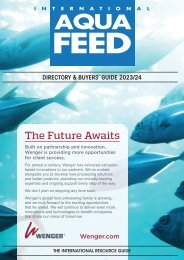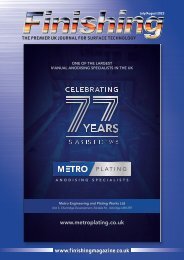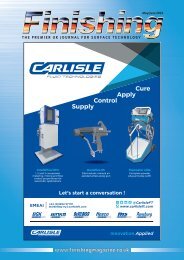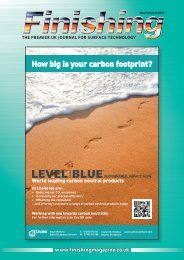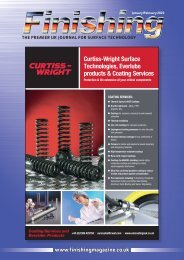Finishing - July-August 2022
This issue has the winners of the galvanizing industry awards, plus an update on the new Carlisle innovation centre. There is also a report from the BCF conference and a review of the Qualicoat conference with took place in London a few weeks ago. It’s great to see that in person events are taking place and that people are excited to go. Long may this continue!
This issue has the winners of the galvanizing industry awards, plus an update on the new Carlisle innovation centre. There is also a report from the BCF conference and a review of the Qualicoat conference with took place in London a few weeks ago. It’s great to see that in person events are taking place and that people are excited to go. Long may this continue!
You also want an ePaper? Increase the reach of your titles
YUMPU automatically turns print PDFs into web optimized ePapers that Google loves.
CASE STUDY 43<br />
example, with the exoskeletal Paexo product<br />
range. A firm commitment towards creating<br />
more quality of life helped this company,<br />
founded in 1919, to become the global<br />
technological leader in “wearable human<br />
bionics”. With more than 8,000 employees<br />
and a sales volume of over one billion Euros,<br />
the company is represented in approximately<br />
60 countries.<br />
Newly organized manufacturing<br />
of components with optimized<br />
processes<br />
For the production of its products the<br />
company is utilizing different manufacturing<br />
technologies. In this context mass finishing<br />
processes play an important role: On the one<br />
hand they must ensure that the products meet<br />
all functional requirements, for example, to be<br />
free of burs. On the other hand, the mass<br />
finishing operations must produce an optically<br />
pleasing surface finish. This also includes the<br />
creation of a highly homogeneous surface<br />
structure on the components, which are<br />
primarily made from aluminum and stainless<br />
steel.<br />
Some products even require a high-gloss<br />
polish. For many years, Ottobock has been<br />
using equipment and consumables supplied<br />
by Rösler.<br />
When the company was looking for new<br />
mass finishing solutions for producing its<br />
components in an optimized and more<br />
sustainable manner, it was only natural that it<br />
turned to Rösler for help. For the initial<br />
processing trials the Customer Experience<br />
Center at Rösler represented the ideal<br />
platform. The center is not only equipped with<br />
the latest equipment for practically all finishing<br />
technologies. But it can also resort to a<br />
portfolio of more than 15,000 media and<br />
compounds, all developed and produced inhouse.<br />
Keramo-Finish operation<br />
replaces a process utilizing<br />
acidic compounds<br />
Among other measures an acid-based<br />
process for creating a high-gloss polish was<br />
replaced by a tailormade Keramo-Finish<br />
operation. This includes the utilization of a<br />
porcelain polishing media in combination with<br />
a special paste and a brightening compound.<br />
The new, acid-free process allows the<br />
complete recycling of the process water. This<br />
has not only resulted in a significant decrease<br />
of the water and compound consumption but<br />
also in a sizable cost reduction.<br />
The polishing operation takes place in a<br />
new, high-performance rotary vibrator, model<br />
R 780 EC. The special shape of the processing<br />
bowl creates a gentle, homogeneous flow of<br />
the media / work piece mix. This ensures that<br />
small and delicate as well as large and bulky<br />
work pieces are quickly polished and<br />
separated in an efficient and gentle manner.<br />
The same operational benefits are also<br />
achieved with the second new rotary vibrator,<br />
model R 420 EC. Together with specially<br />
selected media and compounds Ottobock is<br />
using this machine for a broad spectrum of<br />
applications ranging from deburring and edge<br />
radiusing to surface smoothing.<br />
For the eco-friendly cleaning and recycling<br />
of the process water the two mass finishing<br />
machines are connected to a semi-automatic<br />
Rösler centrifugal cleaning system, model Z<br />
800.<br />
Energy-efficient drying<br />
operation<br />
For drying, the finished work pieces<br />
Ottobock chose the latest version of the RT<br />
550 Euro- DH rotary dryer, also supplied by<br />
Rösler. This patented direct-heat dryer is<br />
equipped with an innovative heat-block<br />
heating system directly mounted to the base<br />
plate of the processing bowl. This ensures a<br />
highly efficient heat transfer with a minimum<br />
of heat loss. Thus, the dryer guarantees not<br />
only a quick, reliable and spot-free drying<br />
operation, but it also allows significant energy<br />
savings, which, compared to conventional<br />
drying systems, can amount up to 40 %.<br />
Therefore, the rotary dryer Euro-DH plays a<br />
key role in a more effective energy<br />
management within the framework of the<br />
recently introduced standard DIN EN ISO<br />
50001. The new dryer also helps reducing the<br />
CO2 emissions and, as a result, represents an<br />
important contribution towards achieving the<br />
required environmental and climate targets.<br />
<strong>Finishing</strong> – <strong>July</strong>/<strong>August</strong> <strong>2022</strong>






